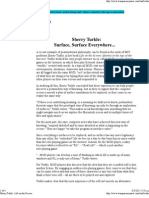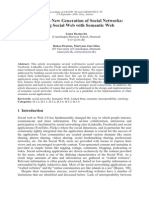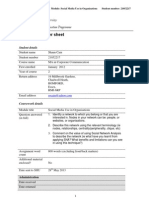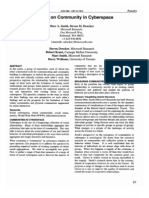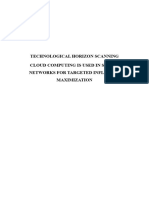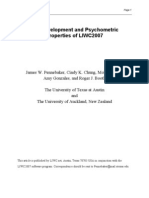Hans en Analyzing Social Media
Hans en Analyzing Social Media
Uploaded by
trappedreflectionCopyright:
Available Formats
Hans en Analyzing Social Media
Hans en Analyzing Social Media
Uploaded by
trappedreflectionCopyright
Available Formats
Share this document
Did you find this document useful?
Is this content inappropriate?
Copyright:
Available Formats
Hans en Analyzing Social Media
Hans en Analyzing Social Media
Uploaded by
trappedreflectionCopyright:
Available Formats
Human-Computer Interaction Lab 27th Annual Symposium
5-27-10
Analyzing Social Media Networks with NodeXL
Derek Hansen1, Cody Dunne2, Ben Shneiderman2 1 iSchool, 2Department of Computer Science Contact: dlhansen@umd;{cdunne, ben}@cs.umd.edu http://nodexl.codeplex.com/
Social media services, such as Facebook, Twitter, and Wikis have enabled new forms of collaboration and interaction in nearly every imaginable human endeavor. And we have only begun to realize the potential of technology-mediated social interaction. Despite numerous success stories, we must remember the countless failures due to social and technical factors. How can we support practitioners in their efforts to cultivate meaningful and sustainable online interaction? One promising strategy is to provide tools and concepts that help practitioners make sense of social media data. There is precedence to this approach in the development of sophisticated, yet fairly intuitive website analytics tools such as Google Analytics. These tools help nonprogrammers understand website traffic patterns so they can make more informed design decisions. We envision an equivalent set of social analytics tools to help social media analysts and community administrators make better decisions based on their in-depth understanding of social participation and relationships. Social network analysis (SNA) provides a set of concepts and techniques for making sense of social data through quantifiable metrics and network visualizations. These complement basic metrics of social participations used in current tools (e.g., number of posts; membership duration) and reveal the patterns in the network that result from social interactions. SNA concepts provide an effective vocabulary to characterize important relational properties of network members, as well as entire network structures. However, SNA also adds significant complexity and imposes obstacles for analysts that lack technical skills. Tools such as Pajek and UCINET have made SNA possible for those with sufficient drive and technical know-how, such as intelligence analysts, computer scientists, and social science doctoral students. With the prevalence of social media network data, there is a great opportunity to make the powerful concepts and techniques of SNA accessible to a much wider audience of community analysts, participants, and designers. Doing so is hardly trivial, leading to the need to address the pressing research question: How can the complex, sophisticated set of SNA techniques be supported in an intuitive manner? To address this question, we have been working as part of a
Figure 1 Dereks personal email network shown in NodeXL, with data represented in the spreadsheet (left) and a network graph (right). Network and social metrics are mapped onto visual attributes including size, opacity, and edge thickness to highlight important people and relationships. Nodes are positioned to identify clusters such as the NodeXL team shown in the middle.
team of researchers funded by Microsoft Research to develop NodeXL, an open source add-in for the widely used spreadsheet application Excel 2007 (see http://nodexl.codeplex.com). It provides a range of basic network analysis and visualization features [1], that we have refined over time based on user studies [2]. NodeXL uses a highly structured workbook template that includes multiple worksheets to store all the information needed to represent a network graph. Network relationships (i.e., graph edges) are represented as an edge list, which contains all pairs of entities that are connected in the network. Complementary worksheets contain information about each vertex and cluster. Data importers allow users to grab networks and user data from popular social media networks such as Twitter, YouTube, Flickr, and email. Visualization features allow users to display a range of network graph representations and map data attributes to visual properties including shape, color, size, transparency, and location (Figure 1).
Human-Computer Interaction Lab 27th Annual Symposium
While there is a need to improve the functionality, efficiency, scalability, and usability of NodeXL, there is also a need to understand how non-technical experts can use NodeXL (and related tools) to understand community interaction. Over the past 2 years we have been studying the process through which non-technical practitioners and students can use NodeXL to make sense of online community data [3] (see Figure 2). Our experience has shown that with minimal training, non-technical students can use NodeXL to generate meaningful graphs and insights from online communities. The tight integration of visualization and data proved key to teaching, understanding, and applying network concepts for beginners [2,3]. NodeXL is now used to teach SNA in dozens of classes around the globe. The ability to automatically capture data was essential for nonprogrammers, as were the layout algorithms. Our studies have led to important improvements in the tool such as the inclusion of a legend and binning of isolate edges, as well as identify additional priorities for network analysis tools such as improved layout algorithms, support for grouping, and working with multi-modal data. We have also been developing usage scenarios that highlight how SNA can be applied to a variety of social media networks in order to derive actionable insights. This work stands in contrast to the majority of SNA work by computer scientists and computational social scientists who characterize the mathematical properties of social media networks, but fail to speak to community administrators trying to gain practical insights. Many of these insights are captured in a forthcoming Morgan-Kaufmann book titled Analyzing Social Media Networks with NodeXL: Insights from a Connected World by Derek Hansen, Ben Shneiderman, and Marc Smith. The book introduces social media networks, social network analysis, and NodeXL to those unfamiliar with these concepts and then applies them to a number of social media including email, discussion forums, Twitter, YouTube, Flickr, wikis, and websites. This work has been funded by Microsoft Research, with significant contributions from Natasa Milic-Frayling (Microsoft Research Cambridge), Marc Smith (Connected Action Consulting Group), Tony Capone (Microsoft Research), Eduarda Mendes Rodrigues (University of Porto), and Jure Leskovec (Stanford University). University of Maryland HCIL contributors include Ben Shneiderman, Derek Hansen, Cody Dunne, Dana Rotman, Elizabeth Bonsignore, Udayan Khourana, and Puneet Sharma.
5-27-10
Figure 2 A network created by Rachel Collins, a student new to SNA in Derek Hansens Communities of Practice class. Bimodal network connecting three Ravelry groups (i.e., forums) represented as blue text boxes to contributors represented as circles. Edge width is based on number of posts (with logarithmic mapping). Vertex size is based on number of completed Ravelry projects. Maroon vertices have a blog and solid circles are either community moderators or volunteer editors. The network helps identify important boundary spanners (e.g., those connected to multiple groups) as well as compare groups.
PAPERS 1. Smith, M., Shneiderman, B., Milic-Frayling, N., Rodrigues, E. M., Barash, V., Dunne, C., et al. Analyzing Social (Media) Network Data with NodeXL. Forthcoming In Proc. C&T 2009. 2. Bonsignore, E.M., Dunne, C., Rotman, D., Smith, M., Capone, T., Hansen, D.L. & Shneiderman, B. (2009), "First steps to NetViz Nirvana: evaluating social network analysis with NodeXL", In SIN '09: Proc. international symposium on Social Intelligence and Networking. IEEE Computer Society Press. 3. Hansen, D., Rotman, D., Bonsignore, E., Milic-Frayling, N., Rodrigues, E., Smith, M., Shneiderman, B. (2009), Do You Know the Way to SNA?: A Process Model for Analyzing and Visualizing Social Media Data. In University of Maryland Tech Report: HCIL-2009-17.
You might also like
- Social Network Analysis and Visualization With RNo ratings yetSocial Network Analysis and Visualization With R4 pages
- AnalyzingSocialMediaNetworkswithNodeXLInsightsfromaConnectedWorldbyDerekHansenBenShneidermanandMarcASmithNo ratings yetAnalyzingSocialMediaNetworkswithNodeXLInsightsfromaConnectedWorldbyDerekHansenBenShneidermanandMarcASmith5 pages
- Analyzing Enterprise Social Media NetworksNo ratings yetAnalyzing Enterprise Social Media Networks6 pages
- Functions of Social Networking ServicesNo ratings yetFunctions of Social Networking Services12 pages
- West Bengal State University: "Facebook Friend SearchingNo ratings yetWest Bengal State University: "Facebook Friend Searching26 pages
- A Cohesion Based Friend Recommendation SystemNo ratings yetA Cohesion Based Friend Recommendation System16 pages
- Big Data Analytics Meets Social Media A Systematic Review of Tech - CompressedNo ratings yetBig Data Analytics Meets Social Media A Systematic Review of Tech - Compressed38 pages
- Zaphiris, Pfeil - 2007 - Introduction To Social Network Analysis (Tutorial) - British Computer Society Conference On Human-Computer InteractionNo ratings yetZaphiris, Pfeil - 2007 - Introduction To Social Network Analysis (Tutorial) - British Computer Society Conference On Human-Computer Interaction2 pages
- Book Review Analyzing Social Media Networks With No Dex lNo ratings yetBook Review Analyzing Social Media Networks With No Dex l5 pages
- Social Network Analysis Using Python Data Mining: Abstract-Analyzing Public Information From SocialNo ratings yetSocial Network Analysis Using Python Data Mining: Abstract-Analyzing Public Information From Social6 pages
- Four Dimensions of Social Network AnalysisNo ratings yetFour Dimensions of Social Network Analysis33 pages
- Digital Media: Content and Communication: Apers Are Invited But Not Limited To The Following AreasNo ratings yetDigital Media: Content and Communication: Apers Are Invited But Not Limited To The Following Areas1 page
- Predictions and Recommendations For The Higher Education Institutions From Facebook Social NetworksNo ratings yetPredictions and Recommendations For The Higher Education Institutions From Facebook Social Networks10 pages
- Applications of Link Prediction in Social Networks A Review100% (1)Applications of Link Prediction in Social Networks A Review18 pages
- Transcending The Individual Human Mind-Creating Shared Understanding Through Collaborative DesignNo ratings yetTranscending The Individual Human Mind-Creating Shared Understanding Through Collaborative Design30 pages
- Developing A Social Platform Using MERN StackNo ratings yetDeveloping A Social Platform Using MERN Stack9 pages
- Ubiquitous Social Media Analysis Third International Workshops, MUSE 2012No ratings yetUbiquitous Social Media Analysis Third International Workshops, MUSE 2012182 pages
- 2006 - The Impact of Social Networking 2.0 On OrganisationsNo ratings yet2006 - The Impact of Social Networking 2.0 On Organisations13 pages
- Usable E-Learning: A Conceptual Model For Evaluation and DesignNo ratings yetUsable E-Learning: A Conceptual Model For Evaluation and Design10 pages
- Kaneetal2014SocialMediaNetworksMISQ (1)No ratings yetKaneetal2014SocialMediaNetworksMISQ (1)31 pages
- Big Data Analytics Meets Social Media, Systematic Review of TechniquesNo ratings yetBig Data Analytics Meets Social Media, Systematic Review of Techniques39 pages
- Functions of Social Networking ServicesNo ratings yetFunctions of Social Networking Services12 pages
- Structural - Social Networks: Twitter AnalysisNo ratings yetStructural - Social Networks: Twitter Analysis18 pages
- Technology Ease of Use Through Social Networking MNo ratings yetTechnology Ease of Use Through Social Networking M13 pages
- Cloud-Based Design and Manufacturing Systems: A Social Network AnalysisNo ratings yetCloud-Based Design and Manufacturing Systems: A Social Network Analysis10 pages
- Assignment Presentation On Social Network AnalysisNo ratings yetAssignment Presentation On Social Network Analysis6 pages
- 1999 CHI Counting On Community in Cyberspace1No ratings yet1999 CHI Counting On Community in Cyberspace12 pages
- Information Fusion: Antonela Tommasel, Daniela GodoyNo ratings yetInformation Fusion: Antonela Tommasel, Daniela Godoy17 pages
- Vizster: Visualizing Online Social Networks: BstractNo ratings yetVizster: Visualizing Online Social Networks: Bstract8 pages
- Statistical Analysis of Network Problems and TheirNo ratings yetStatistical Analysis of Network Problems and Their8 pages
- Marketing Campaign Targeting Using Bridge Extraction in Multiplex Social NetworkNo ratings yetMarketing Campaign Targeting Using Bridge Extraction in Multiplex Social Network22 pages
- Collaboration and Conflict in The Development of A Computerized Dispatch FacilityNo ratings yetCollaboration and Conflict in The Development of A Computerized Dispatch Facility11 pages
- 5 2008 SNAKDD2008-WR SNAKDD 2008 - Social Network Mining and Analysis Post-Workshop ReportNo ratings yet5 2008 SNAKDD2008-WR SNAKDD 2008 - Social Network Mining and Analysis Post-Workshop Report4 pages
- Web Science: An Interdisciplinary Approach To Understanding The WebNo ratings yetWeb Science: An Interdisciplinary Approach To Understanding The Web10 pages
- Weiss Gerhard Multiagent Systems A Modern ApproachNo ratings yetWeiss Gerhard Multiagent Systems A Modern Approach6 pages
- Information Diffusion Online Social NetworksNo ratings yetInformation Diffusion Online Social Networks12 pages
- Social Influence and Spread Dynamics in Social Networks: Xiaolong ZHENG, Yongguang ZHONG, Daniel ZENG, Fei-Yue WANGNo ratings yetSocial Influence and Spread Dynamics in Social Networks: Xiaolong ZHENG, Yongguang ZHONG, Daniel ZENG, Fei-Yue WANG10 pages
- Analysis of Social Networks Using The Techniques of Web MiningNo ratings yetAnalysis of Social Networks Using The Techniques of Web Mining8 pages
- Researching Internet Governance: Methods, Frameworks, FuturesFrom EverandResearching Internet Governance: Methods, Frameworks, FuturesNo ratings yet
- First Aid Is The Provision of Initial Care For An Illness or Injury100% (2)First Aid Is The Provision of Initial Care For An Illness or Injury2 pages
- ESL Librarycom: Simple Present Tense Simple Present Tense in The NegativeNo ratings yetESL Librarycom: Simple Present Tense Simple Present Tense in The Negative4 pages
- HACMP II Administration Student Notebook ERC 1.2No ratings yetHACMP II Administration Student Notebook ERC 1.2250 pages
- Emirates Authority For Standardization & Metrology (ESMA) : UAE Draft Standard (DS1)No ratings yetEmirates Authority For Standardization & Metrology (ESMA) : UAE Draft Standard (DS1)8 pages
- Assessment/Enrollment Form: Guimaras State CollegeNo ratings yetAssessment/Enrollment Form: Guimaras State College1 page
- Design of Yagi Uda With Iron Rod at 2ghzNo ratings yetDesign of Yagi Uda With Iron Rod at 2ghz3 pages
- Face To Face Position Classic and Universal, But Not For100% (1)Face To Face Position Classic and Universal, But Not For7 pages
- Lu3 STF1053 Biodiversity - Species DiversityNo ratings yetLu3 STF1053 Biodiversity - Species Diversity56 pages
- Intel USB 3.0 XHC Driver - Bring Up Guide r1.0No ratings yetIntel USB 3.0 XHC Driver - Bring Up Guide r1.028 pages

